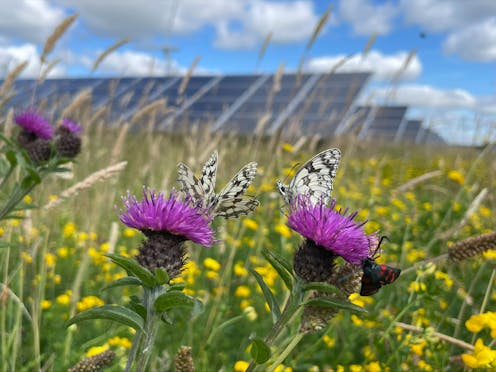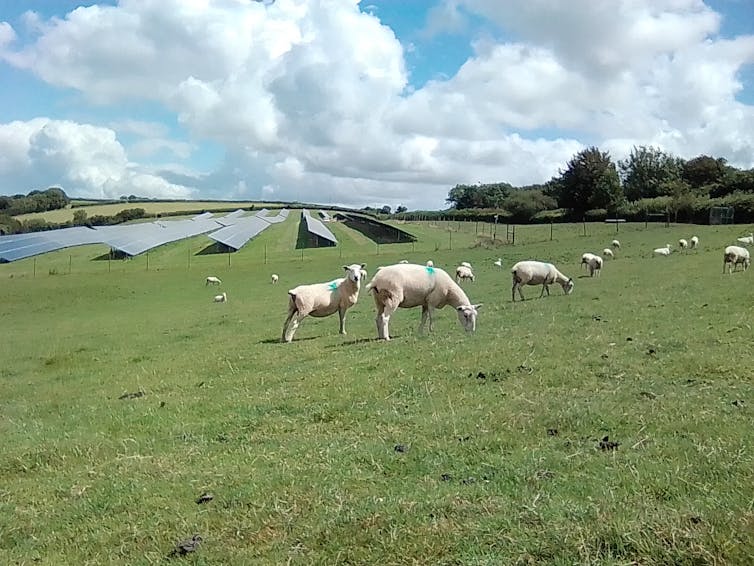
If you were told solar farms could take up to 0.3% of the total land area in the UK by 2035, would you take up a banner and march to parliament in protest? It’s hard to imagine anyone feeling troubled by such a perceptibly small figure.
Instead, if you were told a solar farm the size of 960 football pitches was to be built just outside your front door, would you join your local community to object it as loudly as possible? That’s easier to imagine.
Perceptions of scale and proximity aside, there was no shortage of opposing voices when the new Labour government approved three mega solar farms in the east of England last month – together they account for about two thirds of the entire solar energy capacity installed in 2023.
But solar farms don’t just have to be about low carbon electricity, they could also help reverse biodiversity decline. Under appropriate management and the right policies, solar farms have the potential to deliver benefits for nature and climate.
Our team’s research on solar farms across the UK shows that these energy facilities can boost local pollinator populations and enhance pollination services to adjacent crops. For instance, managing solar farms as wildflower meadows can benefit bumblebee foraging and nesting, while larger solar farms can increase pollinator densities in surrounding landscapes compared to smaller sites managed as turf grass.
Solar farms have been found to boost the diversity and abundance of certain plants, invertebrates and birds, compared to that on farmland, if solar panels are integrated with vegetation, even in urban areas.
Solar farms can also deliver multiple “ecosystem services” in addition to biodiversity conservation, including food production and support for rural activities such as recreation.

Yet, as with any changes, there will be winners and losers. Some species, such as bats, find it harder to forage for insects and travel along protected corridors of habitat due to to the presence of solar farms. The jury is still out on whether solar farms change the soil’s capacity to store carbon. With clearer understanding of how different species respond to the presence of solar farms, the design, location and management of these facilities can be adapted accordingly to benefit nature.
Solar farms may challenge some deeply held perceptions in the UK of a cultural “green” countryside dotted with lush farmlands in which wildlife co-exist in apparent harmony with human-dominated land uses.
However, centuries of agricultural intensification have pushed several species and habitats to the brink in the UK, a nation that’s been highlighted as one of the most nature-depleted countries in the world.
Huge potential
The UK’s commitment to slash carbon emissions to meet net zero targets by 2030 may bring a fivefold increase in solar energy deployment in the next five years. This will probably intensify the debate around competition for agricultural land and community acceptance of solar developments. It also provides an opportunity for policy to embed strong benefits for biodiversity.
Regardless of the potential benefits offered by the creation of wildlife habitats in and around solar farms, one common theme that emerges from most studies is the importance of locating, designing and managing solar farms in a nature-friendly way.
However, design and management alone are unlikely to deliver all the positive outcomes that could be possible from solar farm expansion.
Appropriate public policies that link net zero targets with nature recovery could help ensure that solar farms can be managed to enhance biodiversity. This could happen by making solar farms eligible for financial incentives that promote wildlife. In other words, the new government must roll out policies that will incentivise solar farm operators to manage land in a way that benefits nature, as recommended in our recent study.
The recent announcement by the UK government to review its own environmental improvement plan to deliver legally binding targets to save nature offers a great opportunity to embed solar farms in nature recovery plans, tackle biodiversity loss and increase climate resilience.

Don’t have time to read about climate change as much as you’d like?
Get a weekly roundup in your inbox instead. Every Wednesday, The Conversation’s environment editor writes Imagine, a short email that goes a little deeper into just one climate issue. Join the 35,000+ readers who’ve subscribed so far.
Fabio Carvalho has received funding in the past from Clarkson & Woods Ecological Consultants.
Alona Armstrong receives funding from UKRI, ecological consultancies and the solar industry.
This article was originally published on The Conversation. Read the original article.







